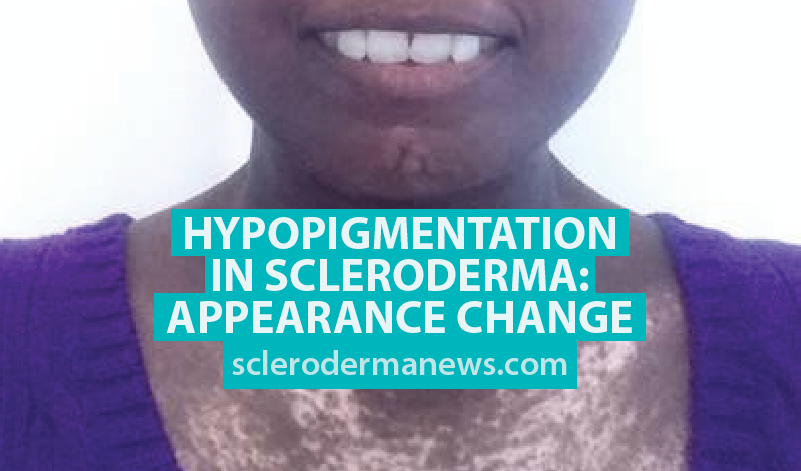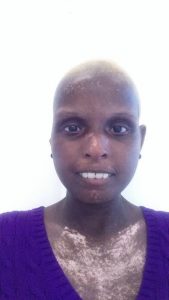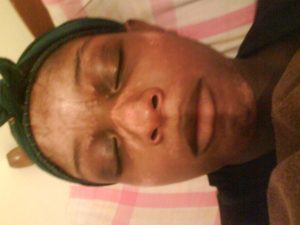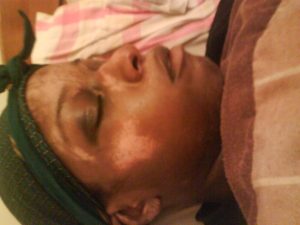Hypopigmentation in Scleroderma: Appearance Change
Written by |

 A Spotlight on the Ssc Scleroderma Symptom Hypopigmentation
A Spotlight on the Ssc Scleroderma Symptom Hypopigmentation

Sarah Jatto from Clapham, South London was diagnosed in 2009 with diffuse Ssc at age 19. Sarah has very kindly agreed to share her experience with the symptom of Hypopigmentation.
‘Hypopigmentation, also known as vitiligo, is something I experienced and was experiencing way before I was diagnosed with Systemic Sclerosis, Scleroderma. A small patch suddenly appeared on my right cheek and it was lighter than my skin tone. In the first instance, I thought nothing of it, the patch meant nothing to me and it did not alter my appearance, and so I did not care for it or about it. “Patch” was just there.
One day I decided to pay my GP a visit to discuss what I did not know I had then…Raynaud’s. I seized the opportunity and told her about the patch on my cheek, to be advised that “it is a virus from the sun.” As perplexed as I was, I said to her “I have not been in the sun,” bearing in mind summer had been and gone many months ago. She prescribed me Canesten and sent me on my way.
I used the Canesten for a while and saw no improvement, in fact I saw quite the opposite. The patch grew bigger and began to spread from my right cheek, to the bridge of my nose, forehead, chest, back, the back of my ears and knuckles. The only places that were spared from the patches, were from my waist down.
It all happened within a blink of an eye, one day I was evenly toned, the next, I was patchy. No warning, no preparation classes or motivational speeches — it was just me, against the ignorance of the world.
I did not know that having an uneven skin tone would cause me such grief daily. Stares from the public, children whispering amongst themselves, and turning back to look at me and laugh with friends. Adults bumping into doors because they could not take their eyes off me, I felt like a freak of nature every single day. One day a lady stopped and asked me “if I was the one they poured acid on?” I was not sure who ‘they’ actually were! Others would ask, whether I had gotten burnt. I do not see how any of this was their business, but that did not stop them from asking.
The ‘burnt’ question was asked a lot. It was asked so much that I questioned friends and family whether or not I looked like a burn victim, so I could gain a better understanding of why that question  was so popular. The responses I got were mixed, a few said yes and many said no, and so, I took on the task of being the judge for my own case. My verdict…inconclusive, I could not see what anybody was talking about. All I could see was a gorgeous young lady with imperfections. I struggle to understand why that could not be up for the debate — it would have been so much easier to answer.
was so popular. The responses I got were mixed, a few said yes and many said no, and so, I took on the task of being the judge for my own case. My verdict…inconclusive, I could not see what anybody was talking about. All I could see was a gorgeous young lady with imperfections. I struggle to understand why that could not be up for the debate — it would have been so much easier to answer.
Wearing make-up had never interested me, and still does not appeal to me, even while my skin was going through the hypopigmentation. I did not see the point of deceiving myself and others. It would not have been cost effective either, because I would need to cover my knuckles and neck, which would probably require half a makeup set, a day, for full coverage.
As time went on, it did not get any easier and I never got used to the unwanted attention, however, I cared less and grew unconcerned. I knew I was beautiful on the outside, I knew I was full of beauty on the inside and that is all that mattered. Nobody and nothing could take that revelation from me and that was enough for me, to keep on smiling and living my life to the fullest.
It took a while for me to get to this ‘acceptance’ stage, however, I am happy to be here, and I have no regrets. Now I can go places without the need for distractions, such as headphones or company and I’m loving it.’
Sarah has been extremely honest and open about her hypopigmentation experience, which I would like to offer huge thanks for. Sarah’s attitude towards her change in her physical appearance is extremely inspiring for those of us who can see the diagnosis bringing about physical changes to our bodies and appearance.
I am sure that the entire global Ssc patient community will also be grateful to Sarah for her honesty as to her true daily reality of living with Scleroderma. Raising awareness into the different symptoms which this diagnosis brings is crucial for improved patient care and best practice.
If you would like to know more about Sarah and follow her Ssc progress please visit her Facebook page:






